ISUZU KB P190 2007 Workshop Repair Manual
Manufacturer: ISUZU, Model Year: 2007, Model line: KB P190, Model: ISUZU KB P190 2007Pages: 6020, PDF Size: 70.23 MB
Page 251 of 6020
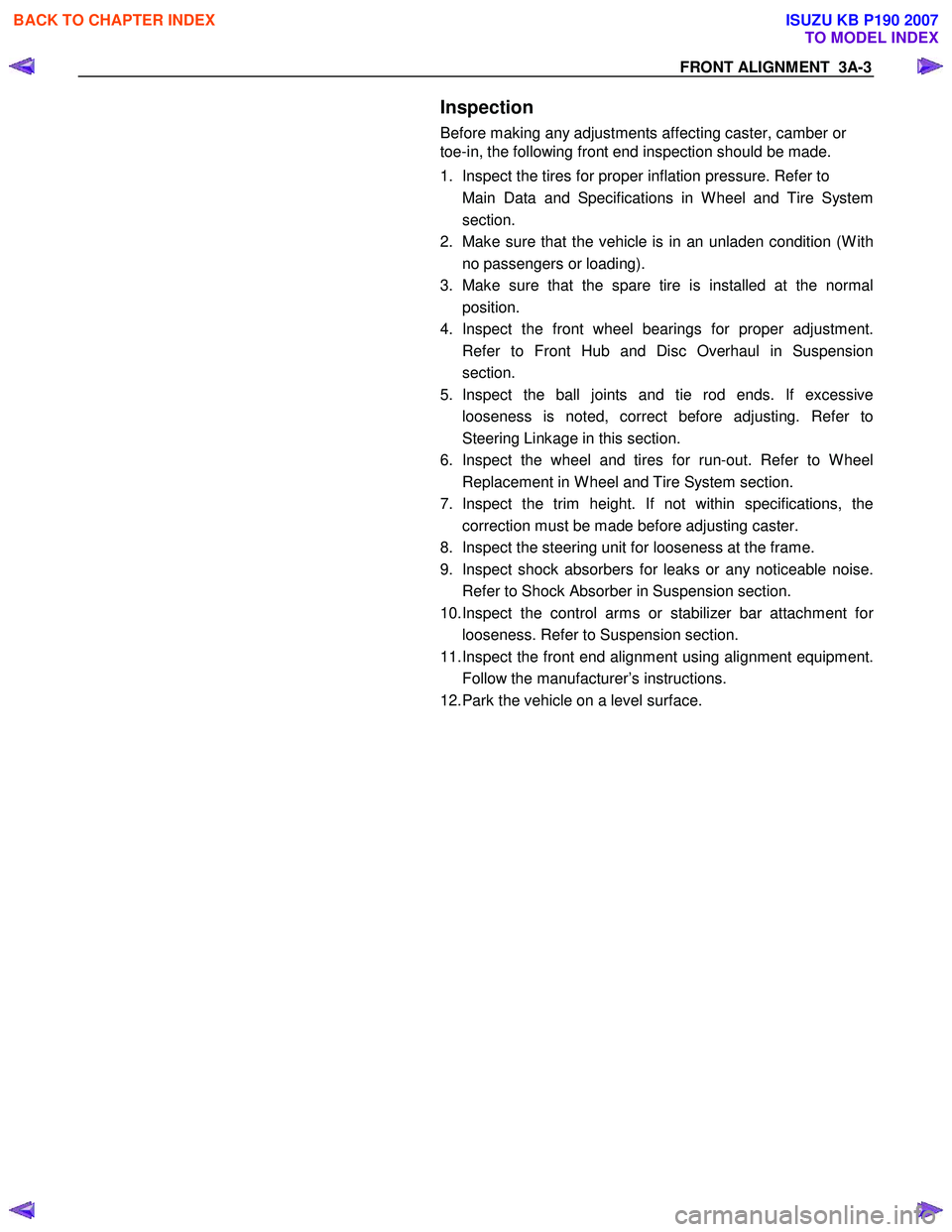
FRONT ALIGNMENT 3A-3
Inspection
Before making any adjustments affecting caster, camber or
toe-in, the following front end inspection should be made.
1. Inspect the tires for proper inflation pressure. Refer to
Main Data and Specifications in W heel and Tire System section.
2. Make sure that the vehicle is in an unladen condition (W ith no passengers or loading).
3. Make sure that the spare tire is installed at the normal position.
4. Inspect the front wheel bearings for proper adjustment. Refer to Front Hub and Disc Overhaul in Suspension
section.
5. Inspect the ball joints and tie rod ends. If excessive looseness is noted, correct before adjusting. Refer to
Steering Linkage in this section.
6. Inspect the wheel and tires for run-out. Refer to W heel Replacement in W heel and Tire System section.
7. Inspect the trim height. If not within specifications, the correction must be made before adjusting caster.
8. Inspect the steering unit for looseness at the frame.
9. Inspect shock absorbers for leaks or any noticeable noise. Refer to Shock Absorber in Suspension section.
10. Inspect the control arms or stabilizer bar attachment fo
r
looseness. Refer to Suspension section.
11. Inspect the front end alignment using alignment equipment. Follow the manufacturer’s instructions.
12. Park the vehicle on a level surface.
BACK TO CHAPTER INDEX
TO MODEL INDEX
ISUZU KB P190 2007
Page 252 of 6020
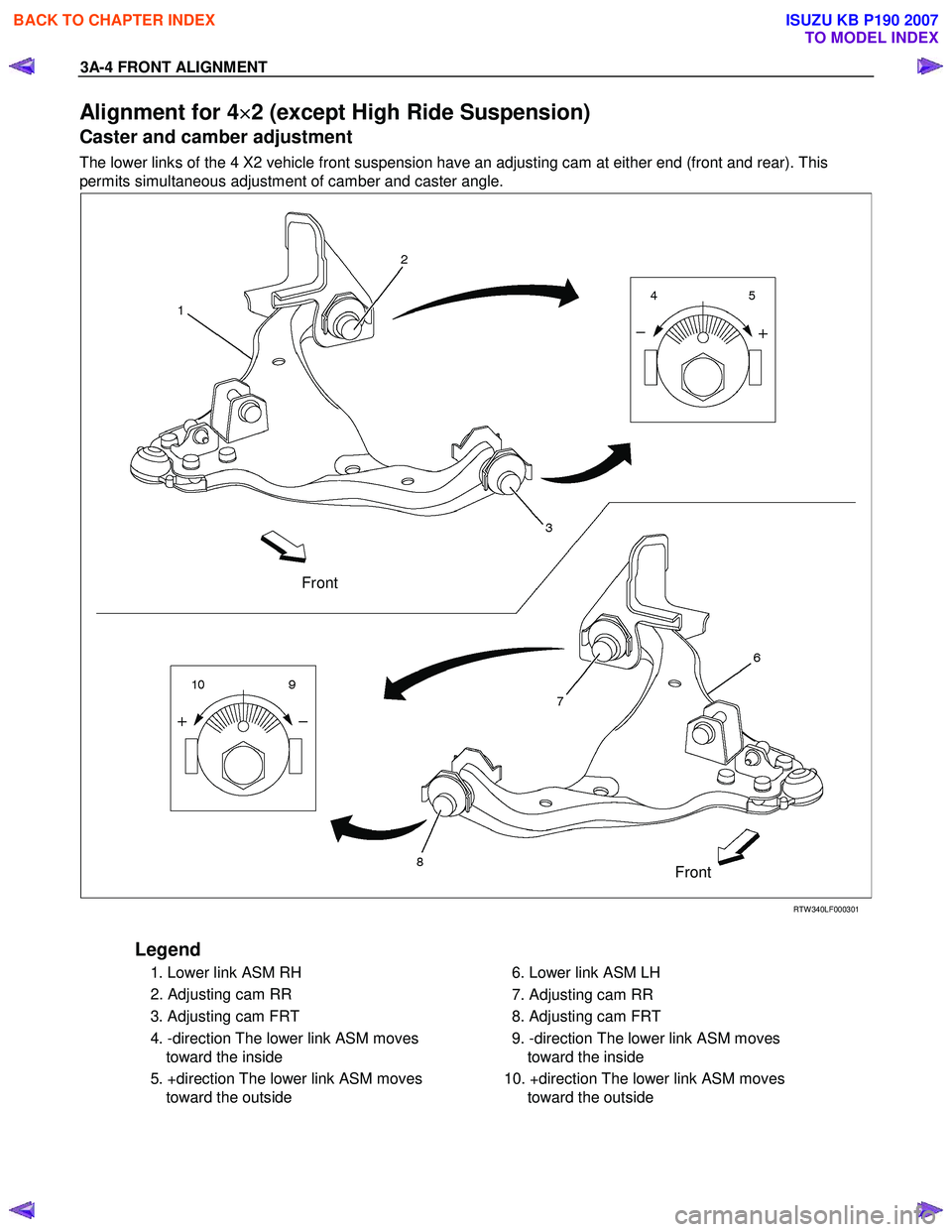
3A-4 FRONT ALIGNMENT
Alignment for 4×
××
×
2 (except High Ride Suspension)
Caster and camber adjustment
The lower links of the 4 X2 vehicle front suspension have an adjusting cam at either end (front and rear). This
permits simultaneous adjustment of camber and caster angle.
Front
Front
RTW 340LF000301
Legend
1. Lower link ASM RH
2. Adjusting cam RR
3. Adjusting cam FRT
4. -direction The lower link ASM moves toward the inside
5. +direction The lower link ASM moves toward the outside
6. Lower link ASM LH
7. Adjusting cam RR
8. Adjusting cam FRT
9. -direction The lower link ASM moves toward the inside
10. +direction The lower link ASM moves toward the outside
BACK TO CHAPTER INDEX
TO MODEL INDEX
ISUZU KB P190 2007
Page 253 of 6020

FRONT ALIGNMENT 3A-5
The following illustration shows the alignment procedure.
RTW 340LF000401
BACK TO CHAPTER INDEX
TO MODEL INDEX
ISUZU KB P190 2007
Page 254 of 6020

3A-6 FRONT ALIGNMENT
Example
Measured value
Camber angle 1 °10' Caster angle 3 °10'
Standard value
Camber angle 0 °±30' Caster angle 3 °35' ±45'
RTW 340SH001001
1. Mark an ‘A’ at the intersection point of the measured
camber angle value (solid line) and the measured caster
angle value (dotted line).
RTW 340SH001101
2. Mark a ‘B’ at the intersection point of the standard camber
angle value (solid line) and the standard caster angle value
(dotted line).
RTW 340SH001201
3. The vertical distance between points ‘A’ and ‘B’ represents
the adjustment required at the front cam. The horizontal
distance between points ‘A’ and ‘B’ represents the
adjustment required at the rear cam.
In this example, the front cam would be moved 5
increments to the positive and the rear cam would be
moved 8 increments to the positive.
CAUTION:
Maximum possible adjustment from the center point of the
cams is 9 increments to either side.
BACK TO CHAPTER INDEX
TO MODEL INDEX
ISUZU KB P190 2007
Page 255 of 6020

FRONT ALIGNMENT 3A-7
CASTER
3
°35' ±45'
Note:
Left and right side to be equal within 30'
CAMBER
0 °± 30'
Note:
Left and right side to be equal within 30'
KING PIN INCLINATION 12°30' ±30'
BACK TO CHAPTER INDEX
TO MODEL INDEX
ISUZU KB P190 2007
Page 256 of 6020
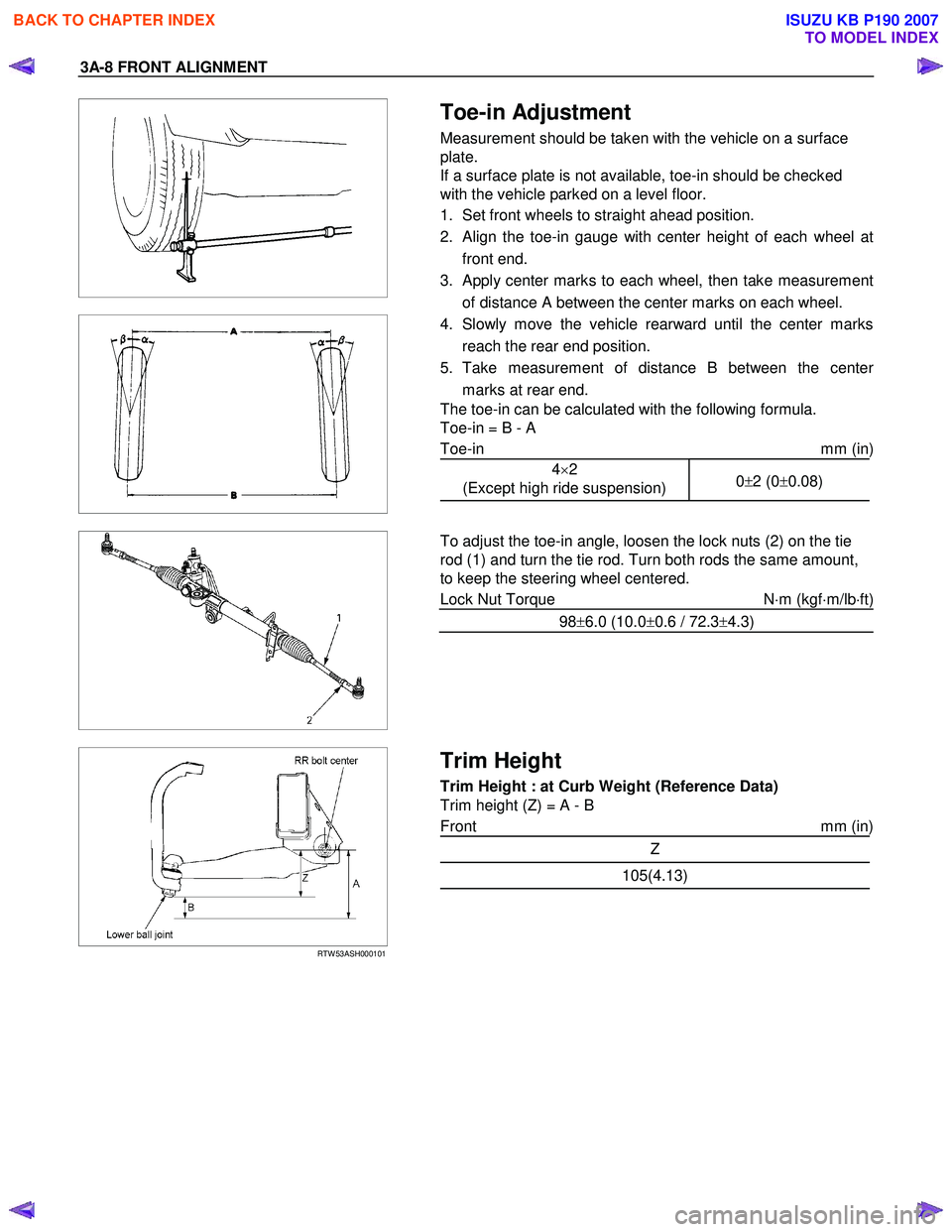
3A-8 FRONT ALIGNMENT
Toe-in Adjustment
Measurement should be taken with the vehicle on a surface
plate.
If a surface plate is not available, toe-in should be checked
with the vehicle parked on a level floor.
1. Set front wheels to straight ahead position.
2. Align the toe-in gauge with center height of each wheel at front end.
3.
Apply center marks to each wheel, then take measurement
of distance A between the center marks on each wheel.
4. Slowly move the vehicle rearward until the center marks reach the rear end position.
5. Take measurement of distance B between the cente
r
marks at rear end.
The toe-in can be calculated with the following formula.
Toe-in = B - A
Toe-in mm (in)
4×2
(Except high ride suspension) 0
±2 (0 ±0.08)
To adjust the toe-in angle, loosen the lock nuts (2) on the tie
rod (1) and turn the tie rod. Turn both rods the same amount,
to keep the steering wheel centered.
Lock Nut Torque N⋅m (kgf ⋅m/lb ⋅ft)
98 ±6.0 (10.0 ±0.6 / 72.3 ±4.3)
RTW 53ASH000101
Trim Height
Trim Height : at Curb Weight (Reference Data)
Trim height (Z) = A - B
Front mm (in)
Z
105(4.13)
BACK TO CHAPTER INDEX
TO MODEL INDEX
ISUZU KB P190 2007
Page 257 of 6020
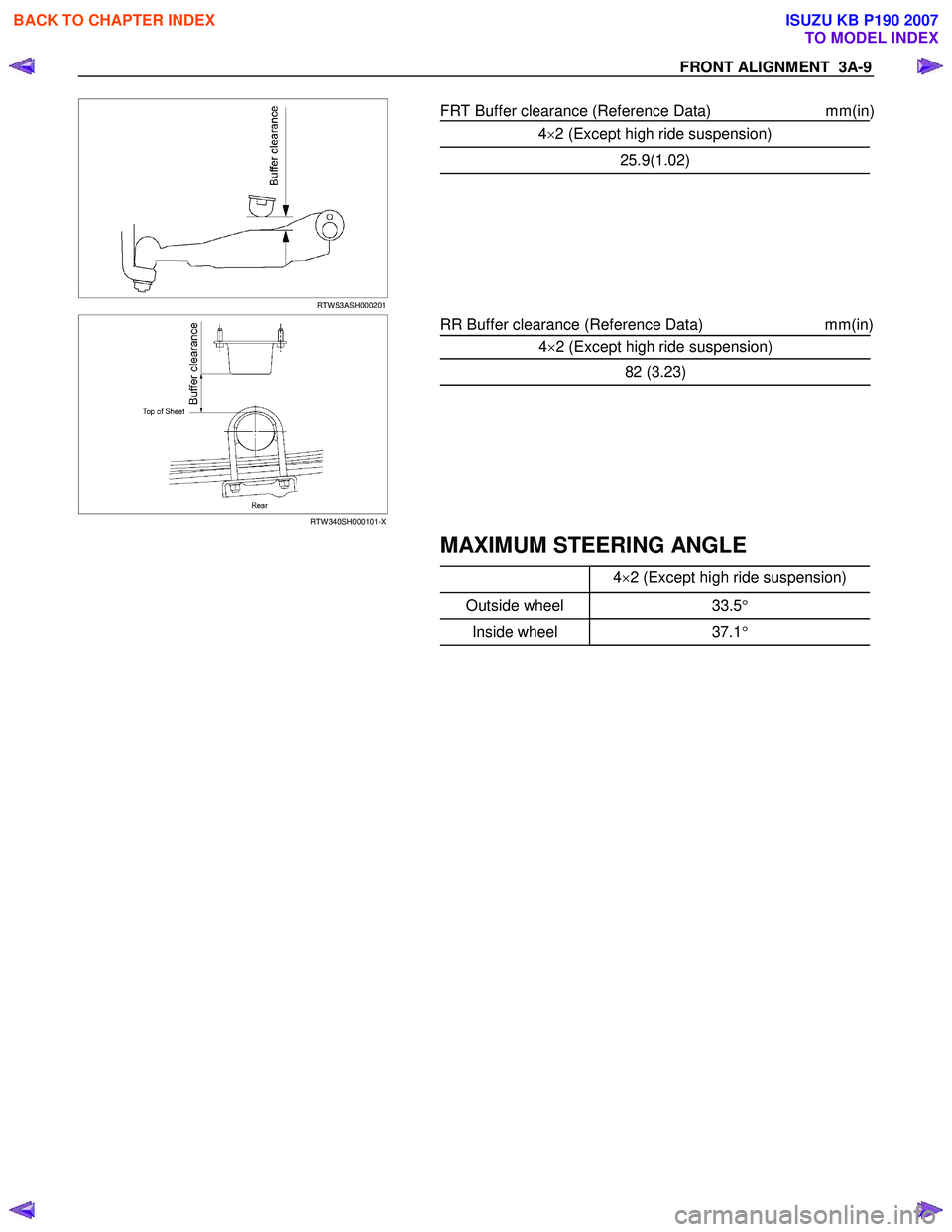
FRONT ALIGNMENT 3A-9
RTW 53ASH000201
FRT Buffer clearance (Reference Data) mm(in)
4×2 (Except high ride suspension)
25.9(1.02)
RTW 340SH000101-X
RR Buffer clearance (Reference Data)
mm(in)
4×2 (Except high ride suspension)
82 (3.23)
MAXIMUM STEERING ANGLE
4
×2 (Except high ride suspension)
Outside wheel 33.5°
Inside wheel 37.1°
BACK TO CHAPTER INDEX
TO MODEL INDEX
ISUZU KB P190 2007
Page 258 of 6020

3A-10 FRONT ALIGNMENT
Alignment for 4×
××
×
2 (High Ride Suspension) and 4 ×
××
×
4
Caster and camber adjustment
The camber angle and caster angle can be adjusted by means of the camber shims and caster shims installed in
position between the chassis frame and fulcrum pins.
RTW 340LF001901
Legend
1. Camber shim
2. Caster shim
3. Upper link ASM LH
4. Lower link ASM LH
5. Adjusting cam
BACK TO CHAPTER INDEX
TO MODEL INDEX
ISUZU KB P190 2007
Page 259 of 6020
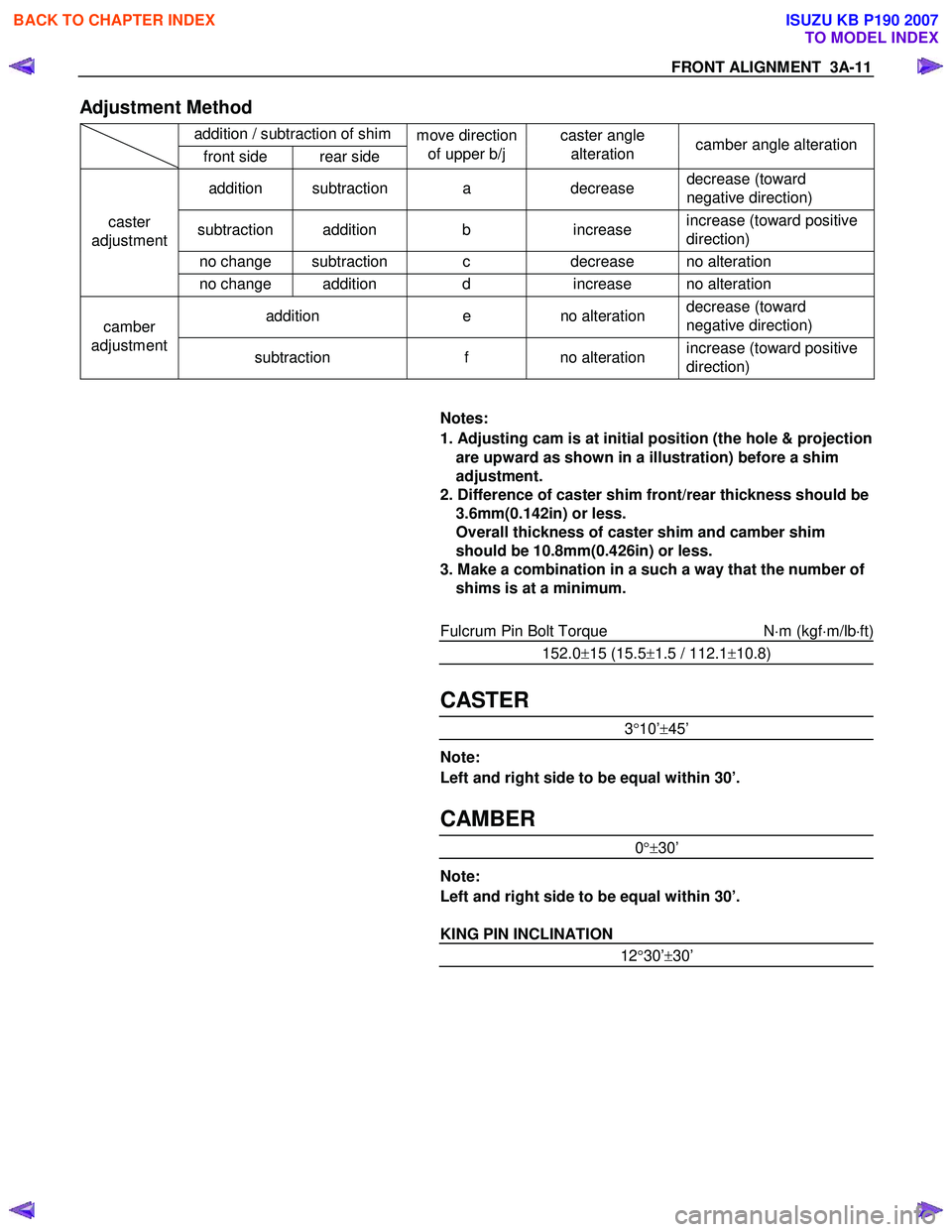
FRONT ALIGNMENT 3A-11
Adjustment Method
addition / subtraction of shim front side rear side move direction
of upper b/j caster angle
alteration camber angle alteration
addition subtraction a decrease decrease (toward
negative direction)
subtraction addition b increase increase (toward positive
direction)
no change subtraction c decrease no alteration
caster
adjustment
no change addition d increase no alteration
addition e no alteration decrease (toward
negative direction) camber
adjustment subtraction f no alteration increase (toward positive
direction)
Notes:
1. Adjusting cam is at initial position (the hole & projection are upward as shown in a illustration) before a shim
adjustment.
2. Difference of caster shim front/rear thickness should be 3.6mm(0.142in) or less.
Overall thickness of caster shim and camber shim
should be 10.8mm(0.426in) or less.
3. Make a combination in a such a way that the number of shims is at a minimum.
Fulcrum Pin Bolt Torque N⋅m (kgf ⋅m/lb ⋅ft)
152.0 ±15 (15.5 ±1.5 / 112.1 ±10.8)
CASTER
3 °10’ ±45’
Note:
Left and right side to be equal within 30’.
CAMBER
0 °± 30’
Note:
Left and right side to be equal within 30’.
KING PIN INCLINATION
12 °30’ ±30’
BACK TO CHAPTER INDEX
TO MODEL INDEX
ISUZU KB P190 2007
Page 260 of 6020
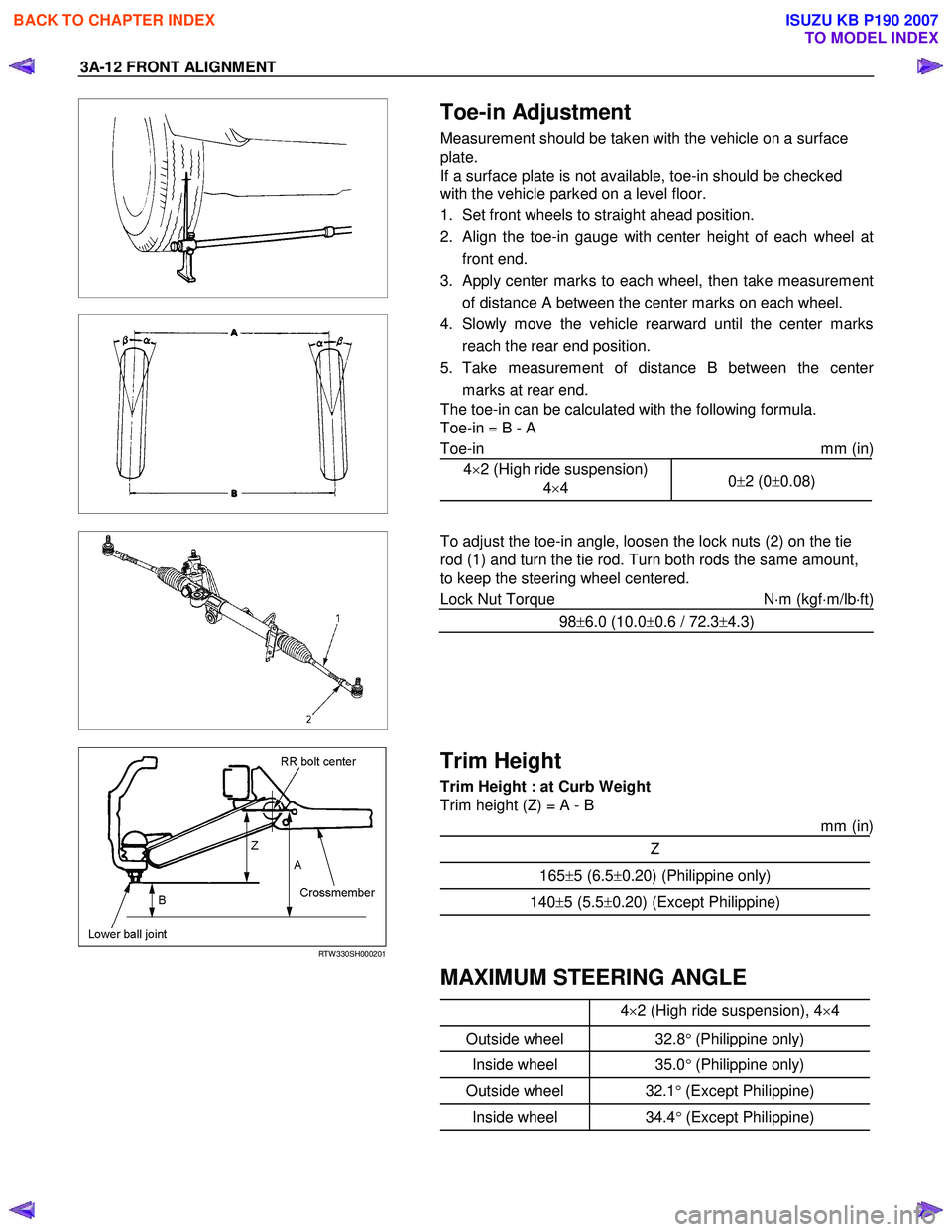
3A-12 FRONT ALIGNMENT
Toe-in Adjustment
Measurement should be taken with the vehicle on a surface
plate.
If a surface plate is not available, toe-in should be checked
with the vehicle parked on a level floor.
1. Set front wheels to straight ahead position.
2. Align the toe-in gauge with center height of each wheel at front end.
3.
Apply center marks to each wheel, then take measurement
of distance A between the center marks on each wheel.
4. Slowly move the vehicle rearward until the center marks reach the rear end position.
5. Take measurement of distance B between the cente
r
marks at rear end.
The toe-in can be calculated with the following formula.
Toe-in = B - A
Toe-in mm (in)
4×2 (High ride suspension)
4×4 0
±2 (0 ±0.08)
To adjust the toe-in angle, loosen the lock nuts (2) on the tie
rod (1) and turn the tie rod. Turn both rods the same amount,
to keep the steering wheel centered.
Lock Nut Torque N⋅m (kgf ⋅m/lb ⋅ft)
98 ±6.0 (10.0 ±0.6 / 72.3 ±4.3)
RTW 330SH000201
Trim Height
Trim Height : at Curb Weight
Trim height (Z) = A - B
mm (in)
Z
165±5 (6.5 ±0.20) (Philippine only)
140 ±5 (5.5 ±0.20) (Except Philippine)
MAXIMUM STEERING ANGLE
4
×2 (High ride suspension), 4 ×4
Outside wheel 32.8° (Philippine only)
Inside wheel 35.0° (Philippine only)
Outside wheel 32.1° (Except Philippine)
Inside wheel 34.4° (Except Philippine)
BACK TO CHAPTER INDEX
TO MODEL INDEX
ISUZU KB P190 2007